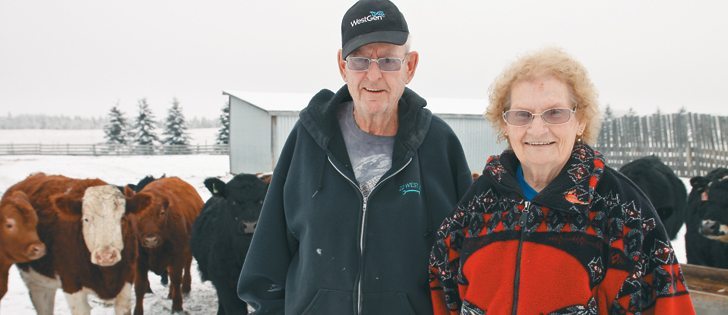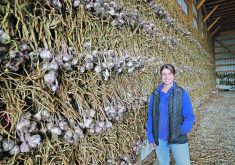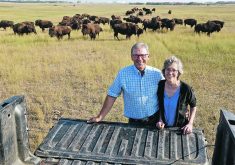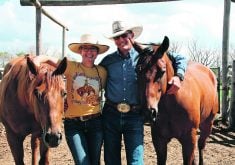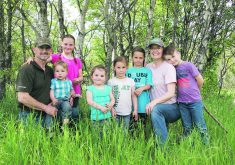INNISFAIL, Alta. — Stan and Marg Coleman are fiddling with their iPhone as they sit at the kitchen table. They are trying to figure out how to work the Google maps app.
Stan, a former truck driver, doesn’t need Google maps to find his way around Alberta, but they’re still interested in how it works.
Later in the day, they plan to set up their new computer.
It’s that enthusiasm for embracing new technology in retirement that took them to the top of their industry.
Read Also

Know what costs are involved in keeping crops in the bin
When you’re looking at full bins and rising calf prices, the human reflex is to hold on and hope for more. That’s not a plan. It’s a bet. Storage has a price tag.
Dozens of banners, ribbons and awards from years of showing Jersey cattle hang on the walls of their farmhouse.
In the basement are more ribbons, photos of their best cows and a five-metre long laminated plastic banner encasing dozens of photos and articles of the couple and their award-winning cattle.
In December, Alberta Milk awarded the Colemans’ the Dairy Industry Achievement Award for work in the industry and for spending hundreds of volunteer hours at agricultural fairs and exhibitions talking about cattle and milk to city residents and schoolchildren.
For years, the couple and their cattle were a fixture at Aggie Days and the Calgary Stampede’s agricultural education events in Calgary. Four times a day, they milked cows and patiently answered questions.
“If they don’t see where milk comes from, they have no idea. They figure it comes from a store,” Marg said. “Bus loads of kids would come to Aggie Days.”
The family also collected a menagerie of goats, sheep, donkeys and other animals for school tours on their Green Hectares Jersey farm.
“We had everything you could imagine. They would come and spend the whole day,” she said.
One lucky group even watched as a calf was born.
The couple moved to the farm in 1965 with their only possessions: two chairs, their clothes and four Jersey heifers that Marg’s parents gave the newly married couple. They moved into an 80-year-old log house and milked cows in an equally old log barn.
“It leaked more inside than outside when it rained,” said Stan.
Marg’s sister was also given four Jersey heifers as a present, but she traded them to the Colemans for four beef cows.
They milked the cows, shipped cream and fed the milk to the pigs. In 1973, they sold the pigs and began shipping milk rich in butter fat.
The family milked 70 cows twice a day at their peak but sold most of the herd in 2003, just before BSE.
They still have four Jersey cows that are milked for colostrum and 100 head of Angus and Shorthorn cattle.
The Coleman’s stuck with Jersey cattle, even when other dairy producers switched to Holsteins.
“I call them ladies’ cows,” said Marg.
“When Stan is gone, they were easy to handle.”
They also added Guernsey, Ayershire and Holstein cattle to the herd over the years.
It was Jersey cattle that kept their interest. The cattle have been sold to farmers in Brazil, Japan, Mexico and most provinces in Canada.
The couple got hooked on showing cattle in 1976 when they won grand champion bull in Edmonton and Calgary.
Another year, a heifer placed in the top 10 at the World Dairy Expo in Madison, Wisconsin, a respectable showing out of the 2,800 cattle at the show.
They moved to purebred Jersey cattle to add value to the herd and attract buyers to the farm. Picking the top cattle was a family decision.
Their son, Greg, had a computer-like mind that could remember cattle pedigrees, said Stan.
“He could go back generations,” said Marg.
Marg was more pragmatic in what was the best cow.
“I only judge the milk in the pail. That is what paid the bills.”
Stan was born six kilometres west of their farm, but moved to Red Deer when he was eight. He joined his brothers trucking after graduation, and it was while hauling a load that he spied land for sale.
He paid $7,200 for the quarter section with the log house and barn and only 30 acres cleared. A year later the couple were milking 21 cows, which gave birth to 18 heifers.
“That really gave us a boost,” said Marg.
The rough, bush-covered land took months to clear.
“We picked roots until we looked like a root,” said Stan.
The farm eventually expanded to slightly more than three quarters.
“We have done well,” he said.
“The cows looked after us.”
Other seniors retire to Arizona, but Marg said they have no intention of leaving the farm or spending their winters in warm vacation spots.
“I don’t think we’re ready for moving any place. I don’t think we need to go to town yet.”
Added Stan: “You can’t ice fish in Arizona.”

